Oroshi Soba is Japanese chilled buckwheat noodles served in a savory dashi-based sauce and topped with grated daikon, shredded nori seaweed, and green onion. It‘s a perfect refreshing noodle dish!
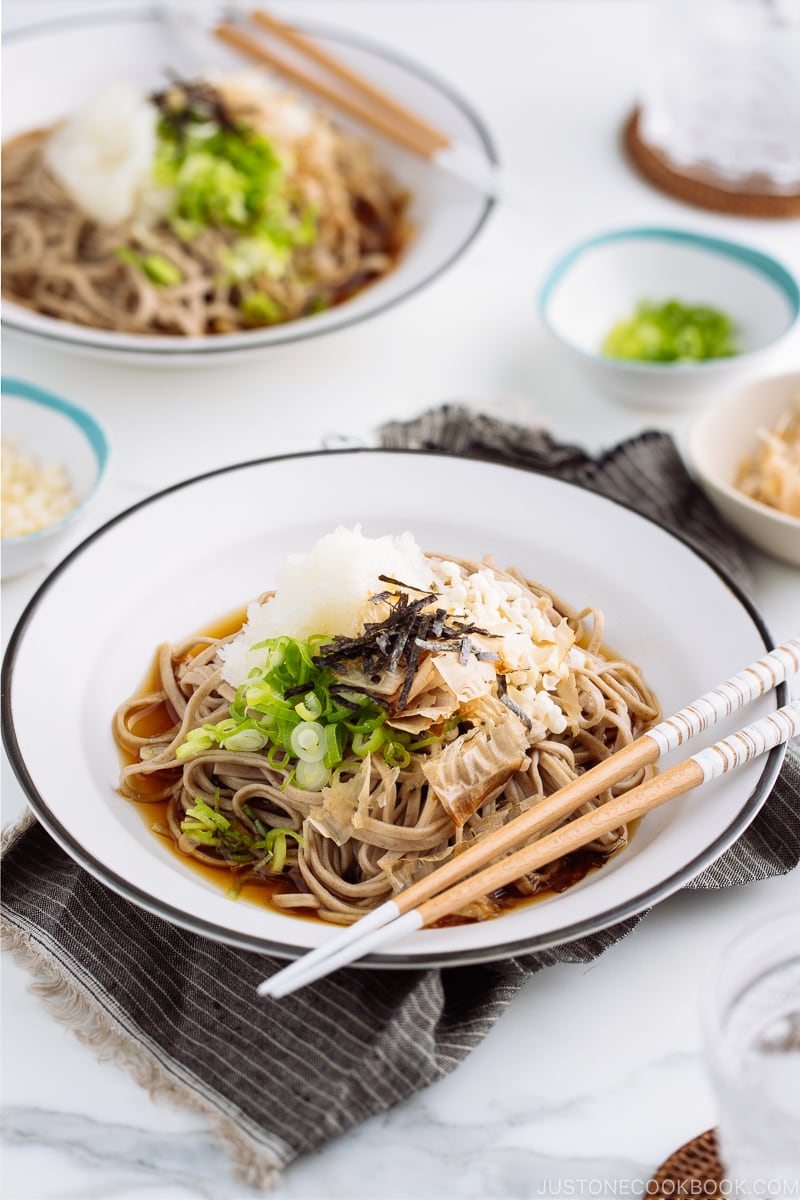
Everyone needs a quick meal that is fresh, nutritious, and delicious. Oroshi Soba (おろし蕎麦) meets exactly the criteria when I need to cook up a healthy meal fast for the family. It uses basic Japanese ingredients like dried soba noodles, dried bonito flakes, scallion, and daikon radish.
When you’re in a hurry, but still want something simple yet satisfying, Oroshi Soba is a recipe you can call on.
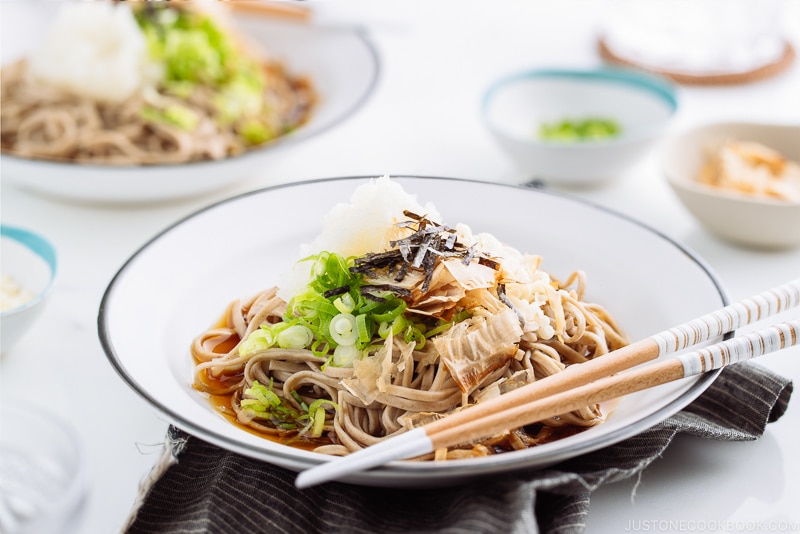
What is Oroshi Soba?
Oroshi Soba (おろし蕎麦) literally means “grated daikon buckwheat noodles.” It’s one of the popular soba noodle menus that you can find at noodle shops in Japan and it’s served hot or cold. The signature of this dish is the grated daikon on top of the noodles.
Many of you probably already know “soba” is a Japanese name for buckwheat noodles. If you’re not sure what is soba or what’s the difference between soba and udon noodles, you can read more here.
Now, “oroshi” means daikon oroshi (大根おろし), which is grated daikon in Japanese. Grated daikon gives a refreshing texture as well as a bit of spicy kick to the dish. We often serve grated daikon with deep-fried foods to lighten the dish. Some of the signature grated daikon dishes include Saikoro Steak, Shrimp Tempura, and Vegetable Tempura, Agedashi Tofu, Tamagoyaki, and Wafu Hambagu.
Where to Get the Best Soba Noodles
Once in a while, I get a question about my favorite brand of soba. To be honest, I didn’t particularly have one until since soba brands are pretty limited here in the U.S. (or outside of Japan in general). However, I was recently introduced to Shinshu Inaka Soba – Komoro Shichibei (信州田舎そば 小諸七兵衛) by Hoshino Bussan (星野物産).
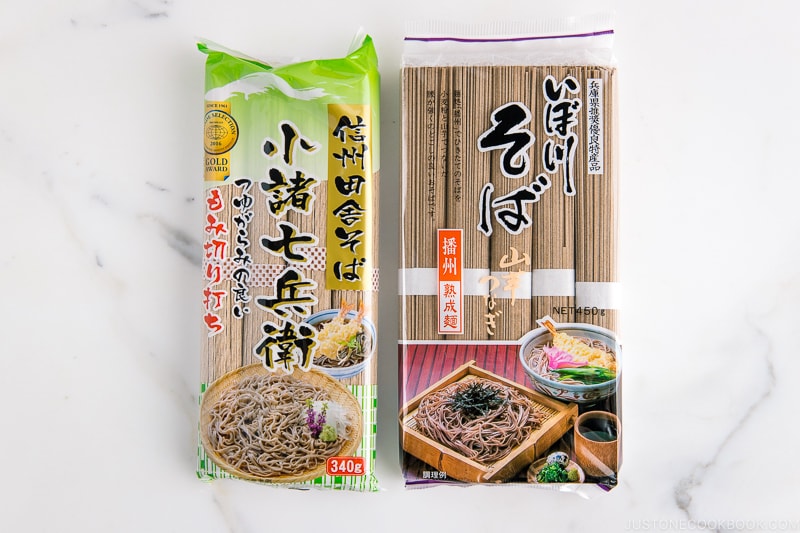
The noodles are a little bit wavy with a nice earthy flavor, and they have the absorbency to soak up the dipping sauce very well. Unlike some soba noodles that tend to develop a mushy, starchy exterior, Shinshu Inaka Soba has a remarkable good bite that stands out immediately. Luckily my local Japanese grocery store Nijiya Market started carrying this brand. If you spot this soba noodle at your local Japanese grocery store next time, grab one and give it a try.
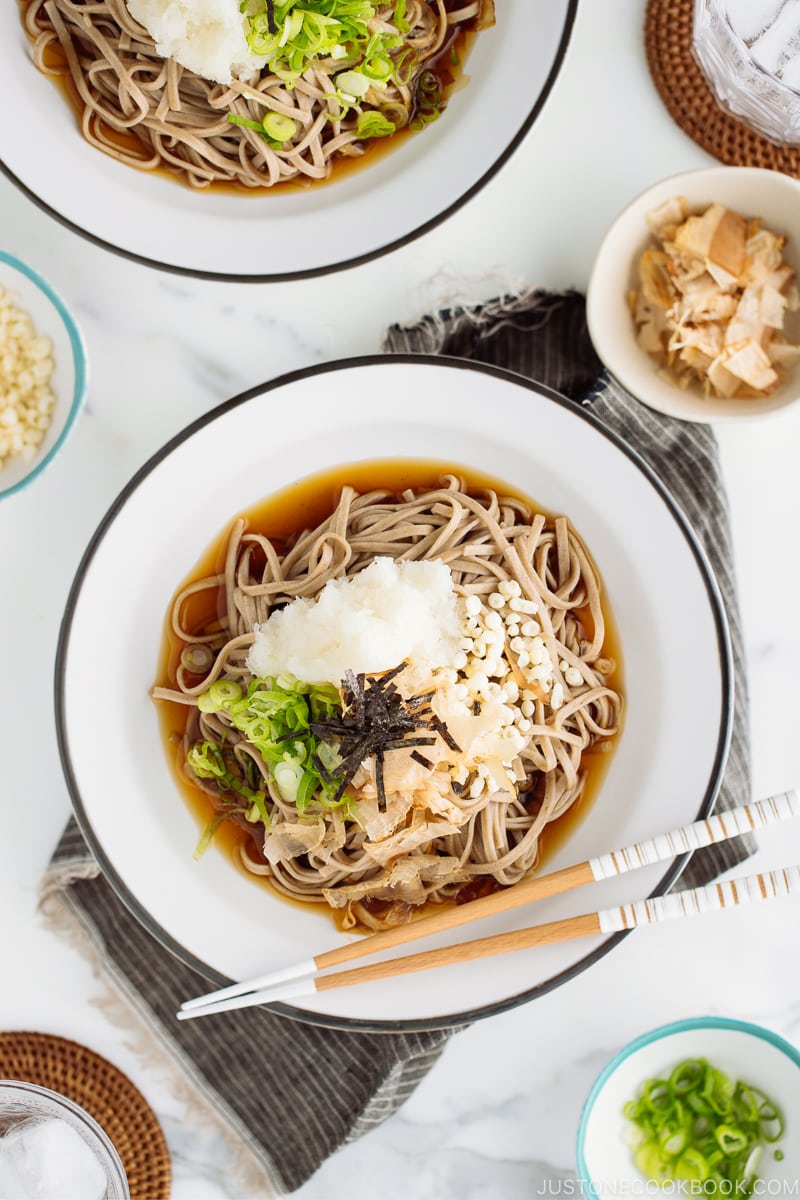
The Key Ingredient – Katsuo Dashi
For a simple recipe like this with minimal ingredients, it’s important to bring out the flavor from each ingredient. Here I used Katsuo Dashi (鰹だし)—Japanese soup stock made with dried bonito flakes. The intensity of katsuo dashi and the additional bonito flakes sprinkled on top provide lots of umami to this simple noodle dish.
It’s very easy to make Katsuo Dashi. You can make a big batch and use some of it to make miso soup for another meal.
How to Make It Vegetarian-Friendly
If you’re vegetarian or vegan, don’t worry. You can make the Japanese soup stock with umami-rich kombu or edible kelp. Kombu Dashi is also very easy to make. The key to extracting good flavor is to slowly bring the kombu to simmer on low heat, which allows the kombu to steep for a longer time.
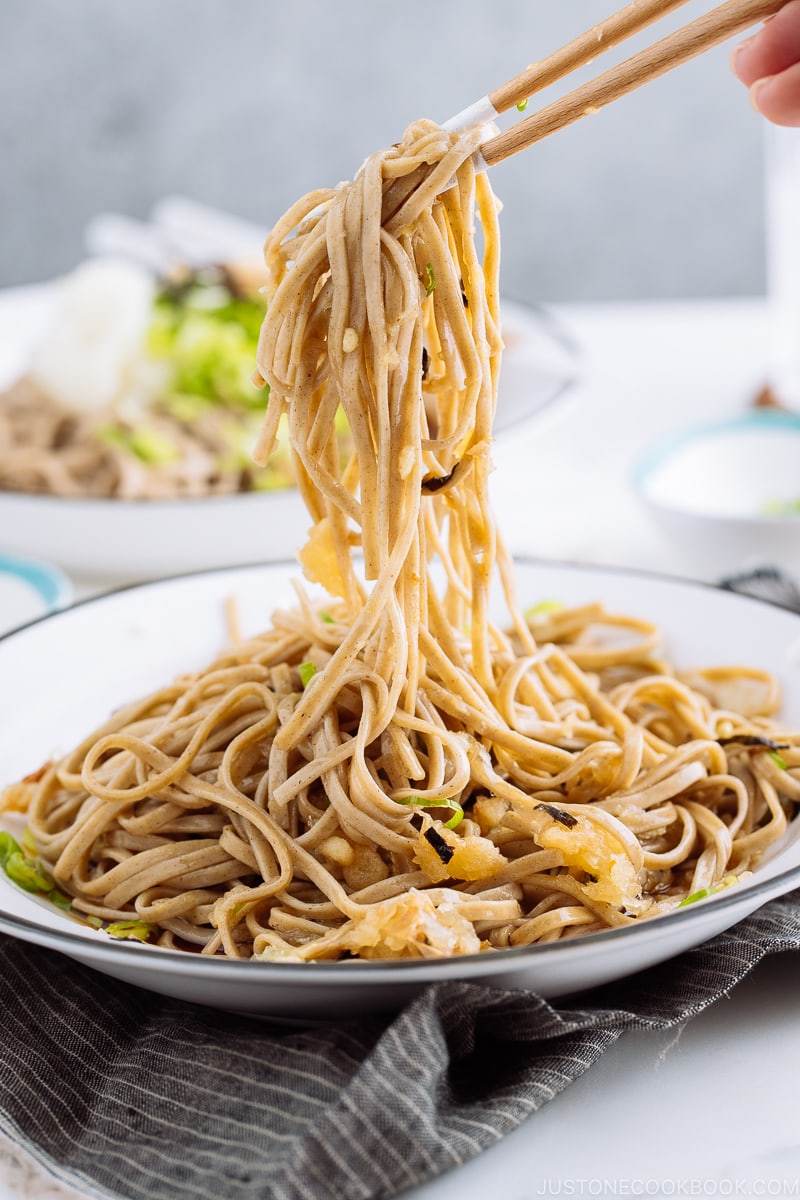
Echizen Oroshi Soba – Fukui Regional Dish
While I was researching online about typical Oroshi Soba in Japan, I learned that it is actually a regional dish in Fukui prefecture, located on the Japan Sea coast in the Chubu region of central Japan. I have never been to Fukui prefecture before, but Fukui prefecture which used to be called “Echizen” has the prefectural “representative food” called Echizen Oroshi Soba (越前おろしそば).
For Echizen Oroshi Soba, the soba noodles are handmade using local buckwheat, and the grated daikon is added to the dashi-based soup (In my recipe, I placed the grated daikon on top of the noodles). Before you eat, you would pour the chilled dashi soup containing grated daikon over the soba noodles.
The toppings are simple and similar to my recipe – katsuobushi and chopped scallion. What they focus on is the quality of soba noodles, the refreshing yet spicy daikon, and freshly shaved quality bonito flakes. It is a minimalist dish that allows each ingredient to shine.
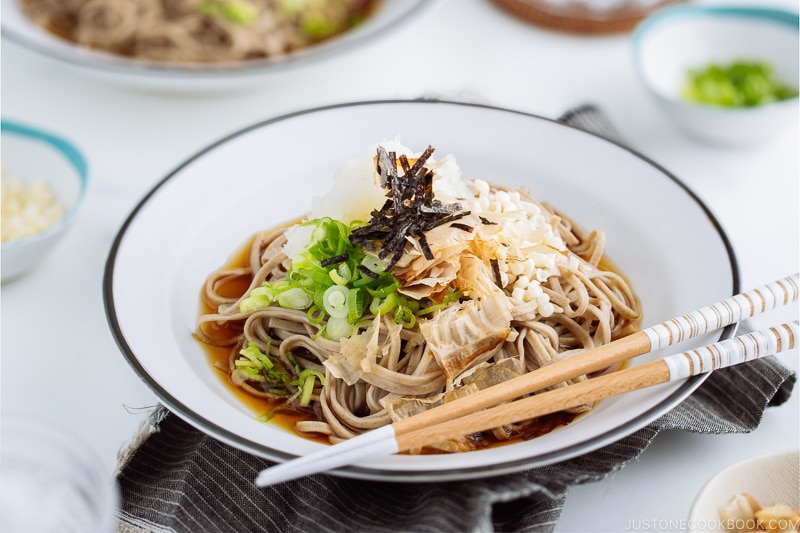
Wish to learn more about Japanese cooking? Sign up for our free newsletter to receive cooking tips & recipe updates! And stay in touch with me on Facebook, Pinterest, YouTube, and Instagram.
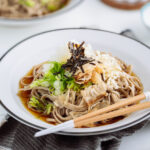
Oroshi Soba
Video
Ingredients
- 6 oz dried soba noodles (buckwheat noodles)
- 7 oz daikon radish (2 inches, 5 cm)
- 1 green onion/scallion (for the topping)
- ½ cup katsuobushi (dried bonito flakes) (for the topping; skip for vegan/vegetarian)
- 3 Tbsp tenkasu/agedama (tempura scraps) (for the topping; optional)
- 1 Tbsp shredded nori seaweed (kizami nori) (for the topping)
For the Sauce
- 1½ cups water (for vegan/vegetarian, make Vegan Dashi)
- 1 cup katsuobushi (dried bonito flakes) (skip for vegan/vegetarian)
- 1 Tbsp mirin
- 1 Tbsp sugar
- 3 Tbsp soy sauce
- ¼ tsp Diamond Crystal kosher salt
Instructions
- Gather all the ingredients.

- In a medium saucepan, add 1½ cups water and heat until nearly boiling.
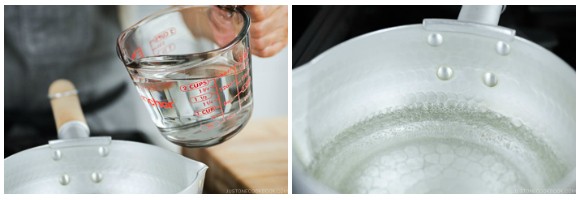
- Add 1 cup katsuobushi (dried bonito flakes) and let it simmer for 15 seconds, and then turn off the heat. Set aside and let the katsuobushi steep for 15 minutes.
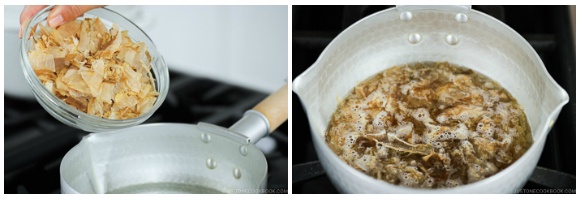
- Meanwhile, peel the skin of 7 oz daikon radish, grate it (I use a ceramic grater), and set aside.
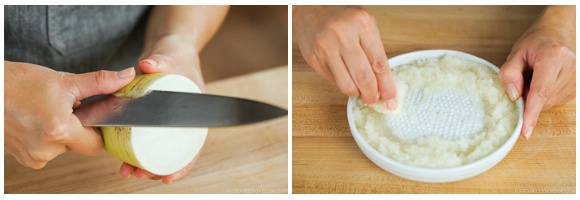
- Cut 1 green onion/scallion into fine rounds.
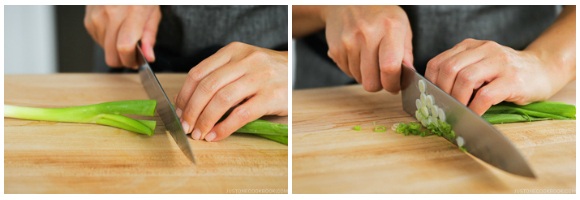
- After 15 minutes of steeping, strain the stock into a measuring cup. You should have 1¼ cups of katsuo dashi. If not, add water.
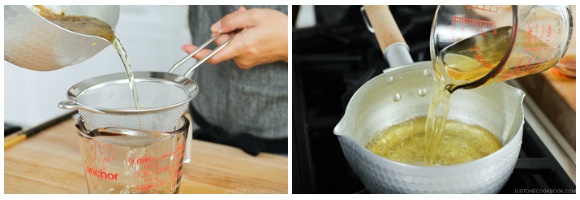
- Add 1 Tbsp mirin, 1 Tbsp sugar, and 3 Tbsp soy sauce. Bring it to boil on medium heat and turn off the heat.
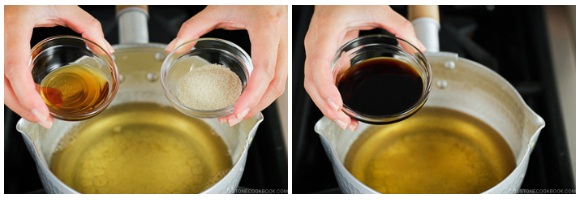
- Mix well and taste it. If necessary, season with ¼ tsp Diamond Crystal kosher salt.
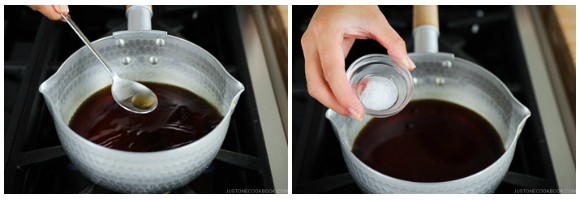
- Place the pot in iced water to cool the sauce down before transferring to the refrigerator (if you are planning to serve later on).
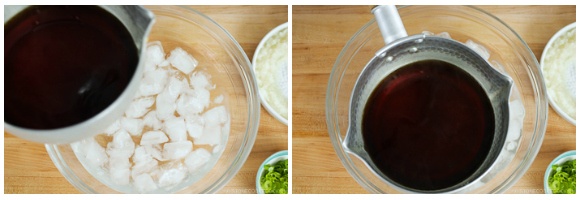
To Cook the Soba
- Bring a large pot of water to a boil. For cooking soba noodles, we do not salt the water. Also, remove the paper bands on 6 oz dried soba noodles (buckwheat noodles) ahead of time. To cook all the soba equally, it’s best to prepare and have it ready to go.
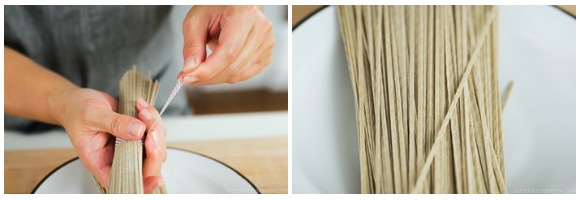
- Once the water is boiling, add the soba and quickly stir so the noodles don’t stick to each other. Cook the soba noodles according to the package instructions. Keep the water boiling on medium to medium-high heat.
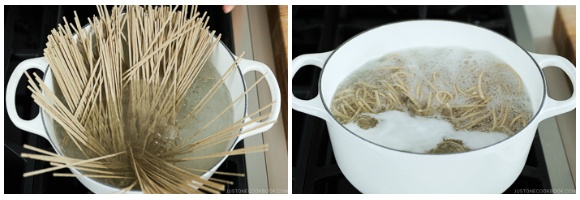
- Drain the soba noodles (you can reserve the soba cooking water called sobayu for drinking). Rinse the soba noodles well under cold water to remove the starch.
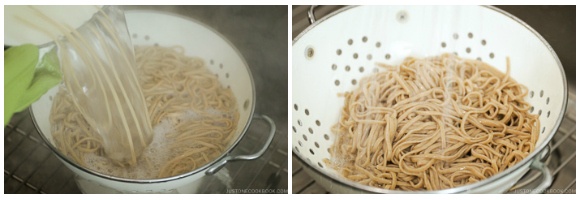
To Serve
- Serve the noodles in individual dishes, and divide the sauce.
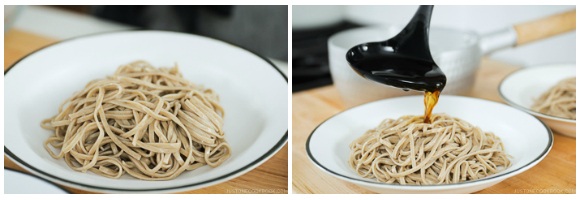
- Now, prepare the toppings. Gently squeeze the grated daikon and place on top of the noodles. (Don’t squeeze too hard and save some moisture so it’s more refreshing, but too much liquid will dilute the sauce.) Top with ½ cup katsuobushi (dried bonito flakes), 3 Tbsp tenkasu/agedama (tempura scraps), the sliced green onion, and 1 Tbsp shredded nori seaweed (kizami nori). Serve immediately.
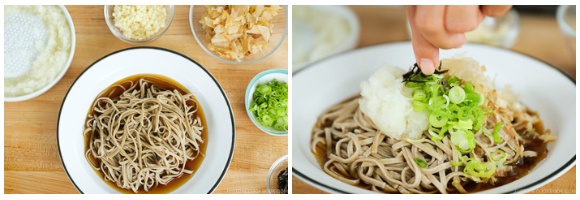
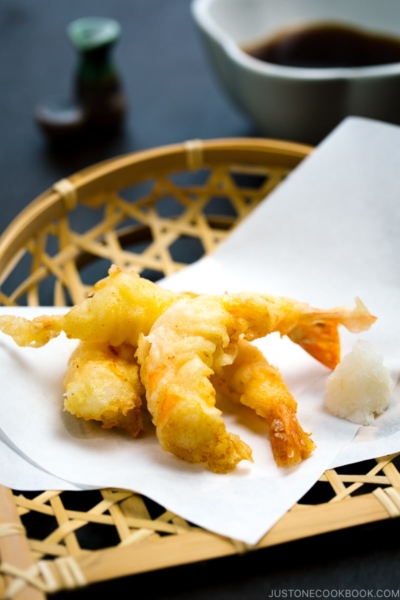
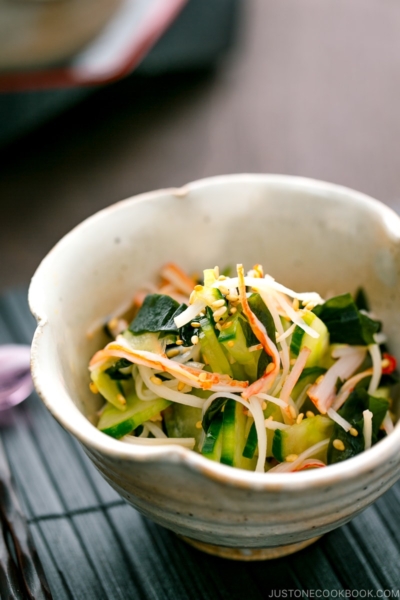

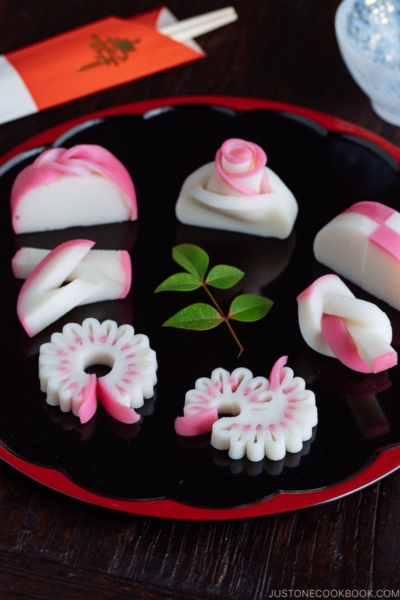




This is undeniably the most amazing thing I have ever cooked in my life. Thank you Nami! I’m going to make this all the time!
Hi Shelli! Aww. We are so happy to hear you enjoyed Oroshi Soba!
Thank you very much for trying Nami’s recipe and for your kind feedback.🙂
Hi Naomi, I am using your recipe for Homemade Mentsuyu. What ratio should I dilute this mentsuyu with water for the sauce?
Hi Daphne! Thank you very much for trying Nami’s recipes!
You can dilute the ratio of Mentsuyu:water = 1:6 and add more water to your taste as you like.
We hope this helps!
Looks so yummy! Is it possible to make the sauce with mentsuyu instead of making it from scratch? What ratio would work?
Hi ella, Thank you very much for your kind feedback.
We recommend diluting more than the dipping noodles ratio if you use Mentsuyu. Depend on which brand of Mentsuyu, the amount of water to Mentsuyu is different. Please see this post for more detail on how to read the instructions on the bottled Mentsuyu.
https://www.justonecookbook.com/mentsuyu/
We hope this helps!
So yummy! We ate it with the noodles and sauce still warm, as it’s winter time 🙂 still awesome!
My Japanese boyfriend can’t go home this year because of covid, so we’re making our way through your recipes to give him a feeling of home, and they have ALL been delicious. THANK YOU thank you ありがとうございま~す!!
Hi Bunny!
Thank you very much for trying this recipe and for your kind feedback!
We are so happy to hear you and your boyfriend enjoyed many of Nami’s recipes, helping him feel at home.
ありがとう〜💕
今日のお昼ごはんはおろしそばを作りました。とても美味しいです! It was very refreshing and the soup was delicious and light, making the natural spice of the daikon really stand out (however it was not too spicy, which is good for my taste). それから晩ごはんは家族と私は牛肉おろしそばと牛ブロスを食べました。もとても美味しいです! それはまだおろしそばですか (まだ大根おろしがありました) ? や別の蕎麦ですか?
Overall, I highly recommend trying this oroshi soba recipe for a hot day. It was a unique experience for cooling off and I was very satisfied.
ナミさん、ありがとうございます!
Hi Jarrett! Thank you so much for trying this recipe and for your kind feedback! とても美味しそうな晩御飯で羨ましいです!
Duplicateのコメント消しておきますね。どうもありがとう!
こんにちは、ナミさん。
日本の食べ物が大好きです、日本に行きたい、と日本語を学んでいます(でもまだ初心者です) 。I have a question about the word “おろし.” Does this word only apply to daikon, or can it be used when grating any vegetable?
ありがとうございます!
-Jarrett Vazquez
こんにちは!わぁ〜日本語上手ですよ!がんばってください!おろし can be used for wasabi, ginger, and daikon. Oh and sometimes apple and onion too!
ありがとうございます! と私はこのレシピを作ります。I can’t wait to try it! 😀
気に入ってもらえると嬉しいです。
Hi
I can’t seem to find daikon anywhere near me, should I just skip it?
Hi Emma! Yes, you can skip it. Just know that grated daikon (oroshi) is the feature for Oroshi Soba. So without the grated daikon, you are making simple soba (nothing is wrong, but we won’t call it Oroshi Soba). 🙂
What other toppings do you recommend?
Hi Candace! Typically, oroshi soba is eaten like this, and other variations with nameko (mushrooms that are slimy, it’s hard to find outside of Japan, unfortunately), natto, or chopped/mashed umeboshi, etc. But if you’re thinking outside of traditional oroshi soba, you can add veggies or any protein you like. 🙂
im going to make this tonight, but I didn’t bring mirin with me to the dorm, should I skip it?
Hi Judy! If you skip, you will need to add sugar as mirin was supposed to sweeten the soup stock.
This Website is absolutely amazing, I love your style of explaining, the instructions are always very clear. Congratulation, you’re doing a stunning work.
Thank you.
Hi Patafikss! Thank you for your kind words and I’m really happy to hear you enjoy the site. We always want to be helpful so let us know if there is any question or things we can improve on. Happy cooking!
I developed a greater appreciation for Japanese cuisine when I moved to Paris, thanks to the many restaurants in Japanese Quarter here. I’ve yet to try cooking Japanese foods in my own kitchen though because I’m not familiar with many of the ingredients. This looks like agreat dish to start with thoug. I’m bookmarking for later – thanks for sharing 🙂
Hi Nita! Good to know there are Japanese restaurants in Paris. Hope you enjoy the recipe!
HI Nami
That looks good & easy to make…
Just some quick queries:
– can we make the sauce in advance & store in fridge like your teriyaki / ponzu sauce recipe and use for another day?
– could we swap the soba with other Japanese style noodles like somen?
????????????
Pardon my heaps of questions
(:
Hi Pat! Thank you for checking this recipe!
1) Yes, you can make the sauce ahead, and good for 3 days in the fridge.
2) Sure, somen and udon can be used. 🙂
No worries at all! Happy to answer your questions anytime!
HI Nami
Great~!!! Shall try this recipe soon! Thank you (:
Hope you enjoy, Pat! 🙂
Soba noodles are my new favorite thing. Gonna try this recipe.
Hi Theresa! I hope you enjoy! It’s delicious (and easy to put it together). 😀